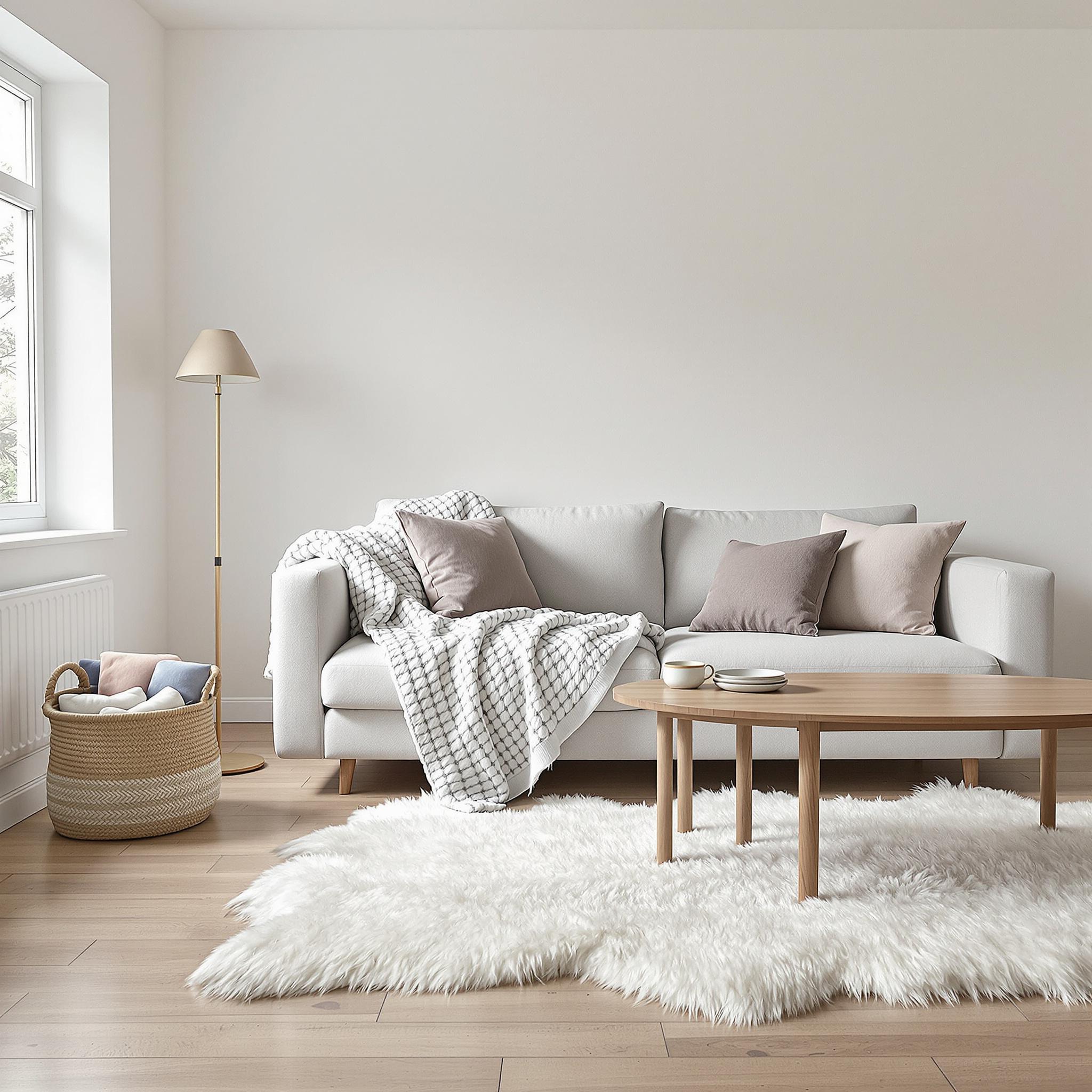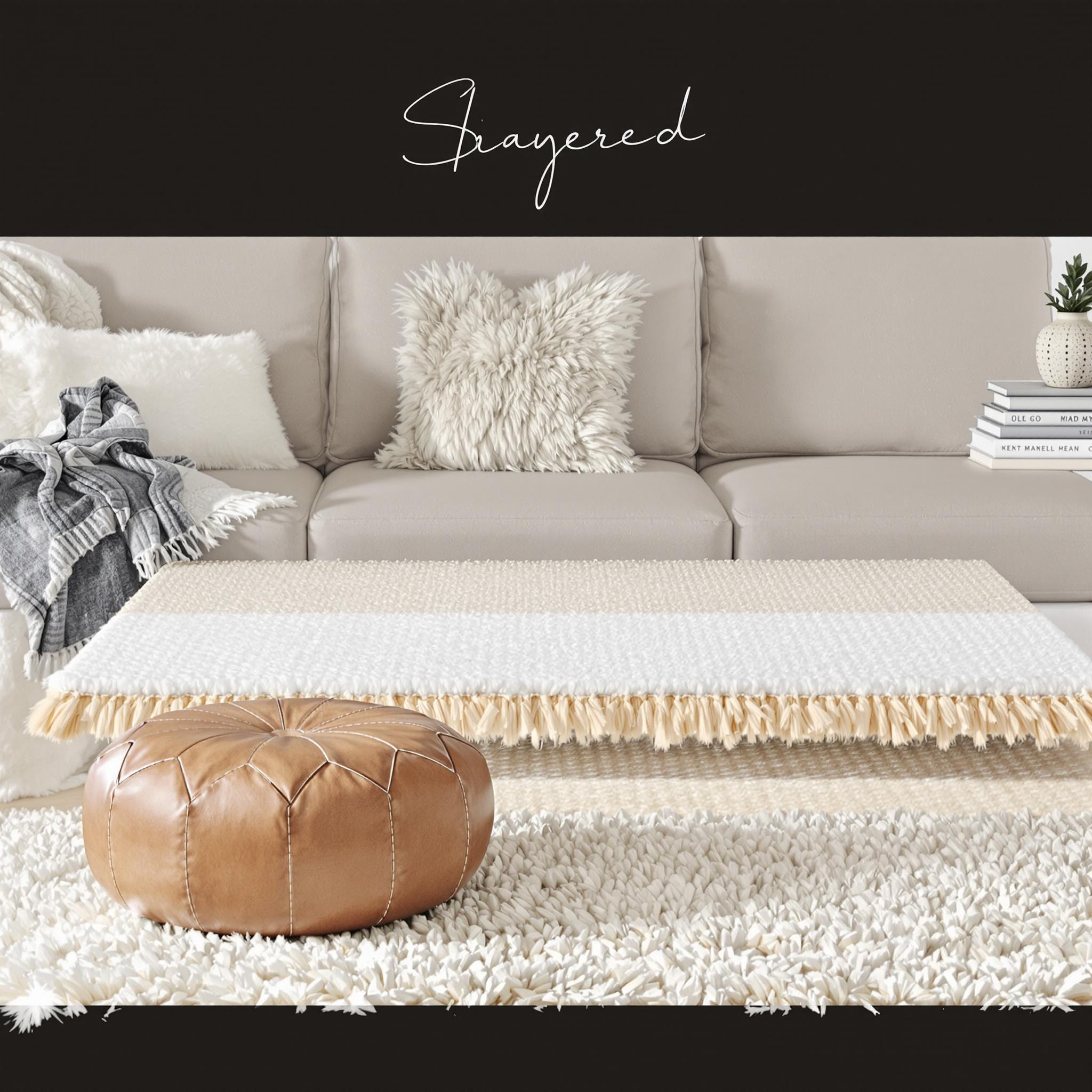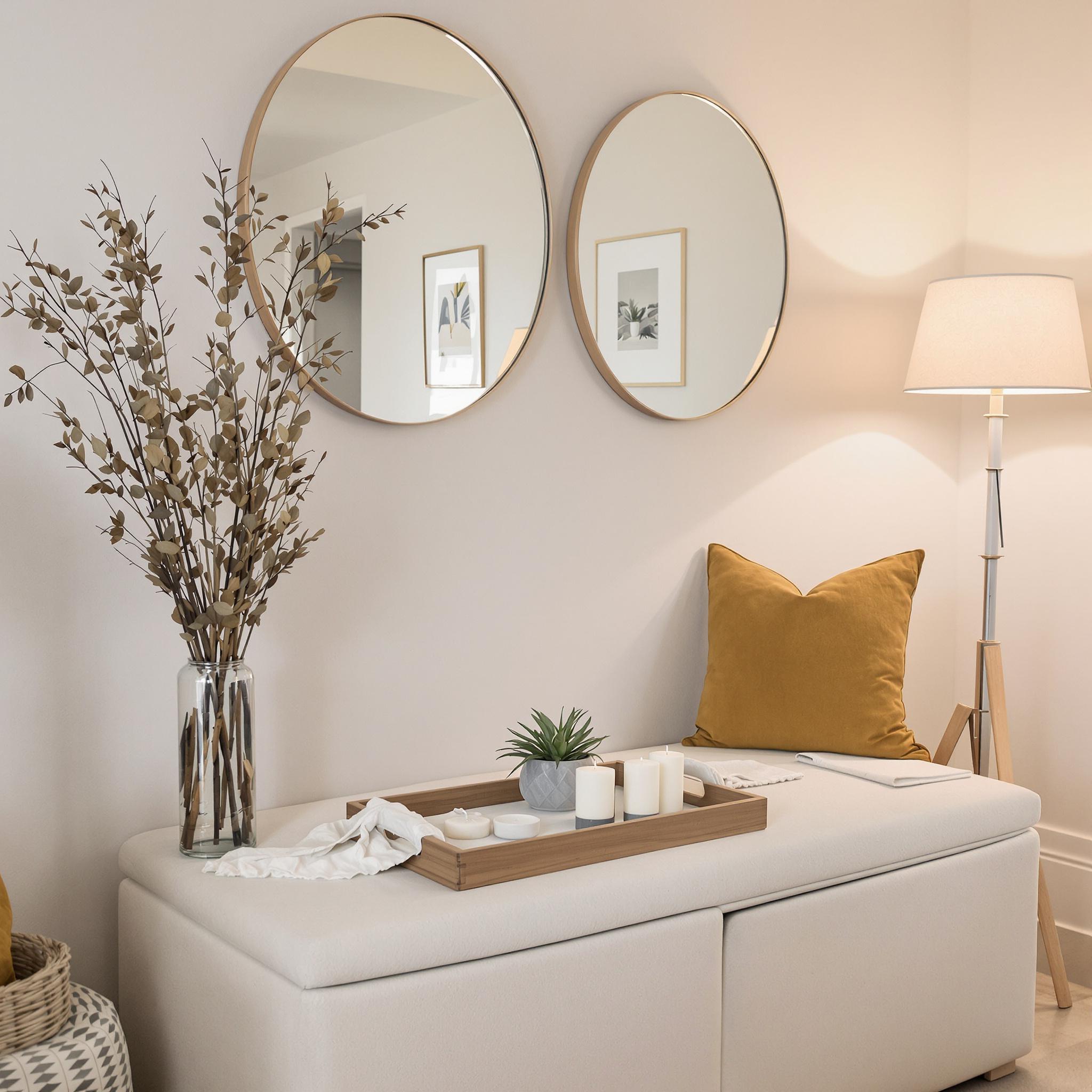What is Scandinavian Design?
Scandinavian design focuses on simplicity, function, and warmth. It started in the Nordic countries during the 1950s. People love it for its clean lines and cozy feel. The style avoids clutter. Every piece has a purpose. Think open spaces, neutral colors, and natural light. Furniture often features wood tones. This creates a calm, inviting home.
Minimalism is key. Less stuff means more breathing room. Functional items double as decor. A chair isn’t just to sit on. It’s also a work of art. Warmth comes from thoughtful details. These small touches make a house feel like a home.
Why Texture Matters in Scandinavian Design
Texture adds life to simple spaces. It keeps things cozy without being messy. Imagine a plain white room. Add a chunky knit blanket. Suddenly, it feels warm and lived-in. Texture makes a space personal. It invites people to touch and explore.
Smooth surfaces like glass or metal can feel cold. Adding soft textures balances this. Think rugs, cushions, or curtains. These elements bring comfort. They also create visual interest. A mix of textures makes a room dynamic.
Transforming a Plain Living Room with Texture
Start with a neutral base. Walls and floors should stay simple. Then layer textures. Here are some ideas:
- A wool rug under the coffee table.
- Linen curtains to soften windows.
- Throw pillows in varied fabrics like velvet or cotton.
- A wooden tray on the coffee table.
- A woven basket for storage.
Each item adds depth. For example, a leather armchair pairs well with a fluffy sheepskin rug. Together, they create contrast. This makes the room feel rich but not overwhelming.
How Texture Creates Cozy Spaces
Coziness comes from layers. Start low and build up. Place a jute rug on the floor. Add a plush sofa. Drape a soft throw over the armrest. These steps make a room welcoming.
I once visited a friend’s home. Her living room had bare walls and sleek furniture. But her sheepskin rug changed everything. Sitting there felt warm and relaxing. That’s the power of texture.
Tips for Using Texture Without Clutter
Balance is crucial. Too much texture feels busy. Stick to a few key pieces. Choose items that serve a purpose. A knitted pouf can act as seating or a footrest. A macramé wall hanging adds art and texture.
Neutral tones help. They let textures shine without competing. Mix smooth and rough surfaces. Pair a glossy lamp with a matte ceramic vase. Keep colors muted. Let the textures do the talking.
Examples of Textures in Action
Imagine a gray couch. Alone, it looks flat. Add a faux fur pillow. Now it pops. Layer a striped blanket. The room feels complete. These small changes make a big impact.
In my own home, I use texture daily. My dining table has a stone top. I paired it with woven placemats. The mix of hard and soft works wonders. Guests always comment on how cozy it feels.
Conclusion of the Section
Texture brings Scandinavian design to life. It adds warmth and personality. Simple rooms become inviting spaces. Use texture wisely. Focus on balance and purpose. Your home will thank you.
Step 1: Start with the Foundation—Because First Impressions Matter
You’ve heard it before: start strong. When layering textures, your base is key. Foundational textures set the tone. Think rugs, curtains, and big furniture pieces. These items do more than add texture; they shape the room’s vibe.
Once, I visited a friend’s place. Her shaggy rug made the room feel like a cozy mountain cabin. She hadn’t done much else, but that rug did all the work. If you’re starting fresh, pick foundational pieces that match the mood you want. A chunky wool rug feels warm. Linen curtains give off a light, airy vibe.
Here’s the catch: don’t overdo it. Stick to one or two standout pieces. Too many bold textures can overwhelm the space before you even get to the fun stuff—throws and cushions. Neutral tones give you more wiggle room later for colors and patterns.
Step 2: Add Mid-Layer Elements—The Heart of the Mix
Now we’re getting somewhere—the mid-layer. This is where your personality shines. Throws, cushions, ottomans, and textured wall art live here. They build on your foundation without taking over.
When I first moved into my apartment, my beige couch was dull. Adding velvet cushions and a knit throw transformed it. The space felt inviting, like “stay awhile.”
Not sure where to start? Mix materials. Pair smooth silk or faux fur with rough jute or woven fabrics. Group similar textures in odd numbers—it looks better. And don’t forget scale! A large pouf with smaller pillows creates balance.
- Pick 2-3 materials (velvet, cotton, leather).
- Vary sizes and shapes (round vs. square, long vs. short).
- Stick to a color palette—neutrals with one pop of color.
Don’t stress perfection. Sometimes tossing a blanket casually works better than folding it neatly. Life’s messy anyway.
Step 3: Finish with Decor Items—The Cherry on Top
Now for the finishing touches—the decor. These small details make people notice. Baskets, ceramics, books, plants, and sculptures fall here. They might seem minor, but they matter.
I once stayed at a boutique hotel. What stood out wasn’t the fancy furniture—it was a tiny ceramic vase on the bedside table. It made the room feel thoughtful.
When choosing decor, think about how it works with other textures. A woven basket adds warmth next to leather. A glossy bowl contrasts nicely against matte wood. Plants are great—they add life and soften sharp lines.
But watch out for clutter. There’s a fine line between charming and chaotic. If surfaces are full, step back and edit. Keep only what you love—or at least what looks good.
Tips for Balancing Neutrals and Pops of Color
Let’s talk color. Sticking to neutrals is smart when layering textures. Beige, gray, white, and taupe create a calm base. But adding subtle color makes it pop.
My living room is mostly neutral—a cream sectional, light floors, ivory curtains. I added a mustard pillow and navy blanket. It’s not too much, but it draws attention. Subtle works.
Here’s how to nail it:
- Pick 1-2 accent colors and sprinkle them around.
- Use accessories like vases, candles, or art to add color.
- Try patterned textiles—but keep them minimal. One striped cushion is enough.
Pro tip: start small if you’re unsure. Swap throw pillows seasonally or switch decor items occasionally. Experiment without fully committing.
Avoiding Over-Cluttering—Less Is More, Trust Me
Confession: I used to over-clutter. My college dorm looked like a thrift store explosion. Pillows everywhere, books stacked high, knick-knacks galore. It felt homey but chaotic. Lesson learned: less is more.
Editing is key. Be intentional. Ask yourself: Does this piece add value? Enhance the look? If not, let it go.
Another trick: group similar items. Instead of scattering bowls, cluster them on a tray. It looks tidier and creates focus.
Negative space matters. Leaving areas bare gives the eye a break. Think of it as breathing room. You wouldn’t cram every inch of a page, right? Same idea here.
Final Thoughts Before You Get Started
Layering textures doesn’t have to be scary. It’s like making a playlist—you want variety, rhythm, and surprises. Start with your base, add mid-layers, and finish with decor. Sprinkle in color and embrace imperfection.
The best part? There’s no right or wrong. Your home should reflect *you*, quirks included. Grab that fuzzy throw, rearrange those cushions, and enjoy the process. That’s what decorating’s all about, isn’t it?
Layering Textures Like a Pro: Practical Tips for Your Scandinavian Living Room
You know what’s kind of funny? When I first tried to nail that cozy Scandinavian look, I thought slapping down a sheepskin rug and painting the walls white would do it. Spoiler: it didn’t. Turns out, layering textures is where the magic happens. Let me break it down—no fluff, just real talk.
Start by mixing materials like wool, linen, and wood. A chunky knit throw on your sofa adds warmth fast. A jute rug underfoot brings in an earthy vibe. And pillows? Mix sizes, shapes, and fabrics—velvet, cotton, even leather—and watch your space come alive. Quick tip: odd numbers work better than even ones. Try three cushions instead of two. Trust me.
If you’re worried about overdoing it, stick to neutral tones as your base. Then add muted pops of color with accessories like vases or artwork. It keeps things balanced without feeling chaotic.
Avoid These Common Mistakes (And Fix Them Like a Boss)
Let’s get real for a second. There are some rookie mistakes people make when aiming for that Scandinavian look. First, overcrowding. I once visited a friend’s tiny living room, and it felt more cluttered than cozy because they crammed in too much furniture. The fix? Edit ruthlessly. Keep only what you love and need. Less really is more.
Another big no-no? Ignoring lighting. Scandinavian design loves natural light, but not everyone has huge windows. So, invest in good fixtures—pendant lamps with warm bulbs or sleek table lamps. Funny story: I found a vintage lamp at a thrift store last year, and it became the star of my living room. Total win.
Lastly, don’t be too matchy-matchy. Consistency is key, but everything perfectly coordinated can feel cold. Mix old and new—a modern coffee table with a vintage armchair works wonders.
Hacks for Small Spaces and Budget Constraints
Here’s the deal: not everyone has a giant loft or endless cash. But you can still rock a cozy Scandinavian living room without breaking the bank—or your brain. Start with multi-functional furniture. A storage ottoman doubles as seating *and* hides blankets. Genius, right?
Mirrors are lifesavers for small spaces. They bounce light around and make rooms feel bigger. I got a round mirror from IKEA—it cost almost nothing but made my room feel twice as spacious. Who says budget-friendly can’t be stylish?
Don’t forget DIY projects. Last winter, I refreshed my throw pillows by sewing covers from old fabric scraps. Saved money and added a personal touch. Plus, there’s something cool about saying, “Oh, thanks! I made that.”
Seasonal Updates That Keep Things Fresh
One of the best things about Scandinavian design is how adaptable it is. Want to switch things up for fall? Swap light linen throws for heavier knits in mustard or rust. Add pinecones or dried leaves to your coffee table for instant autumn vibes.
In spring, lighten things up with pastel accents or fresh greenery. Last March, I brought home eucalyptus branches from the market and stuck them in a tall vase. My friends wouldn’t stop complimenting it. Such an easy win.
For winter, candles are essential. Scandinavians practically live by candlelight during those long, dark months. Stock up on unscented pillar candles and scatter them around. Bonus points if you use brass or ceramic holders for extra style.
Personalizing Without Losing the Scandinavian Soul
Nobody wants a cookie-cutter living room. Personal touches matter, but how do you stay true to Scandinavian minimalism? Focus on meaningful details. Hang family photos in simple frames or display travel souvenirs that tell a story. I’ve got a little ceramic elephant from Thailand on my bookshelf, and it always makes me smile.
Artwork is another great way to add personality. Go for abstract prints or watercolors in soft hues. If you’re artistic, why not paint something yourself? Even a small piece can make a big impact.
Random thought: plants are nature’s decor. Whether it’s a fiddle-leaf fig or a cluster of succulents, greenery adds life and texture. Just pick low-maintenance options if you’re like me and sometimes forget to water them.
Final Thoughts: Cozy Meets Cool
At the end of the day, creating a cozy Scandinavian living room isn’t about perfection. It’s about making a space that feels like *you*. Layer textures thoughtfully, avoid common mistakes, and refresh with seasonal updates. Most importantly, don’t stress if your budget’s tight or your space is small. With a bit of creativity, you can nail that Nordic look without losing comfort or individuality.
FAQs About Creating a Cozy Scandinavian Living Room
Q1: What colors work best for a Scandinavian-inspired living room?
Stick to neutrals like whites, grays, and beiges. Add subtle accents in muted tones like sage green, blush pink, or navy blue.
Q2: How can I incorporate plants into my design?
Choose low-maintenance plants like snake plants, pothos, or succulents. Place them on shelves, side tables, or hang them near windows.
Q3: Is it okay to mix metals in Scandinavian decor?
Yes! Mixing metals like brass, copper, and matte black adds interest. Just keep it balanced so it doesn’t feel overwhelming.
Q4: Can I use patterned textiles in a Scandinavian room?
Sure, but keep patterns minimal. Think geometric designs or simple stripes in neutral colors, not bold prints.
Q5: How do I make a small living room feel bigger?
Use mirrors, declutter often, and pick furniture with exposed legs. Light-colored walls and smart lighting also help.
Q6: Are rugs necessary in Scandinavian design?
Not mandatory, but rugs add warmth and texture. Natural fiber rugs like jute or sisal fit perfectly.
Q7: Where can I find affordable Scandinavian-style furniture?
Check IKEA, Target, or Wayfair. Thrift shops and Facebook Marketplace are also great for budget finds.
Q8: How do I style a gallery wall without it looking messy?
Stick to a theme, like black-and-white photos or botanical prints. Use evenly spaced frames and limit pieces to five or seven.
Q9: Should I avoid bright colors entirely?
Nope! Bright colors can work in moderation. Use them in accessories like cushions, rugs, or artwork to keep balance.
Q10: How often should I update my decor?
It’s up to you, but seasonal updates are fun. Swap smaller items like throws, pillows, or centerpieces every few months.



